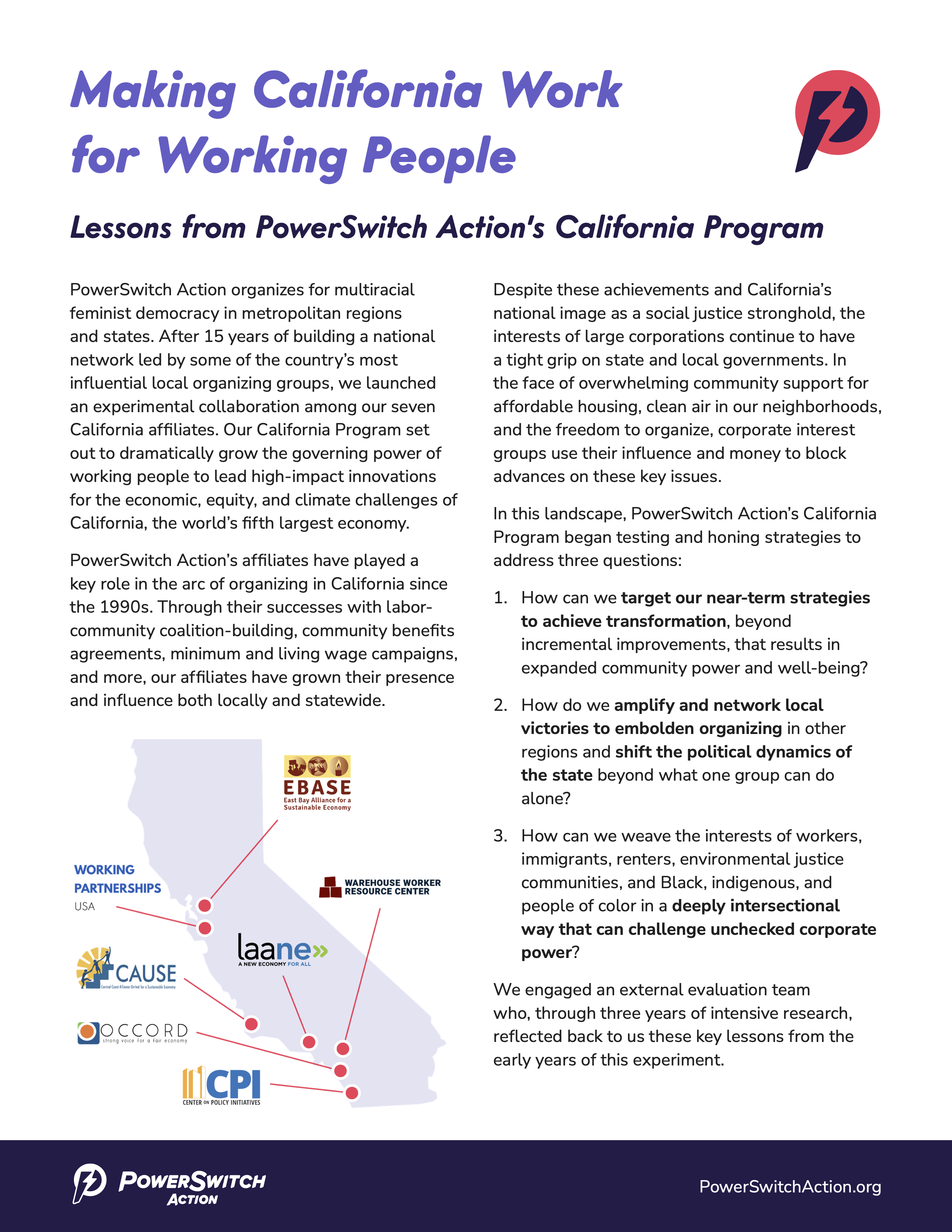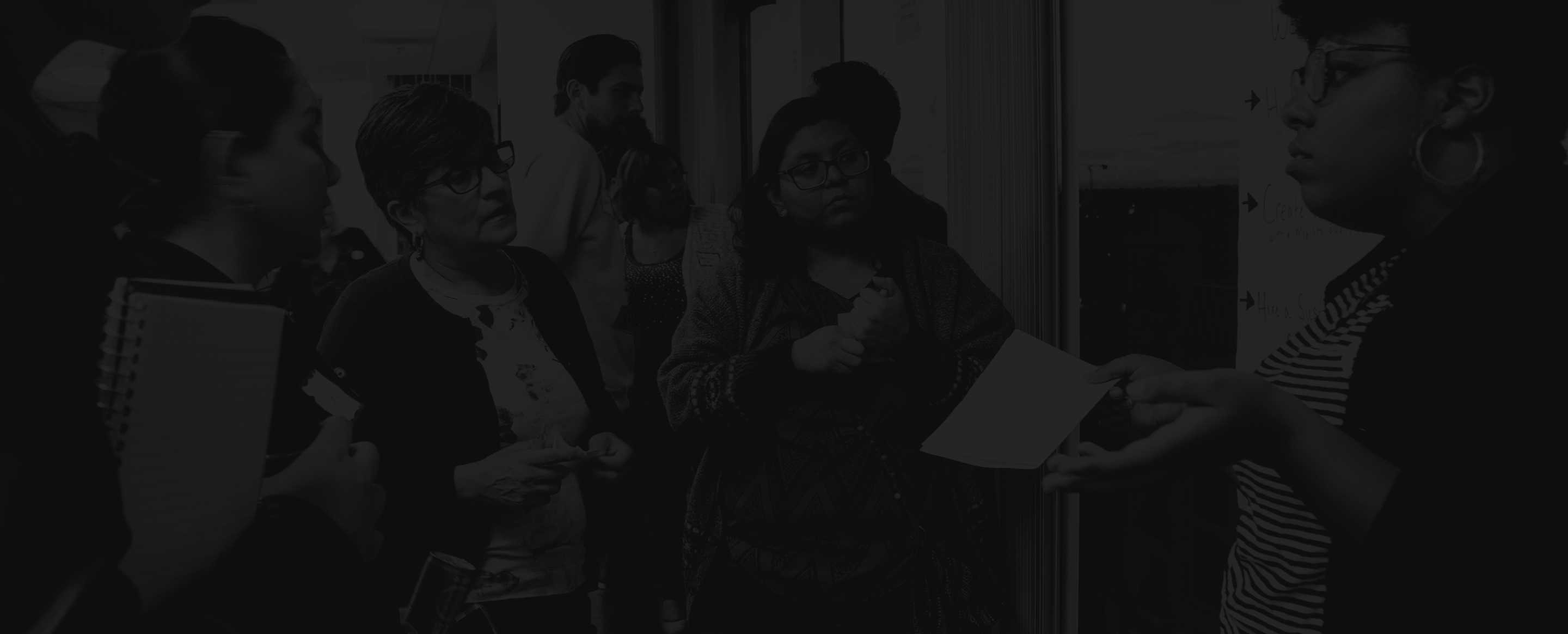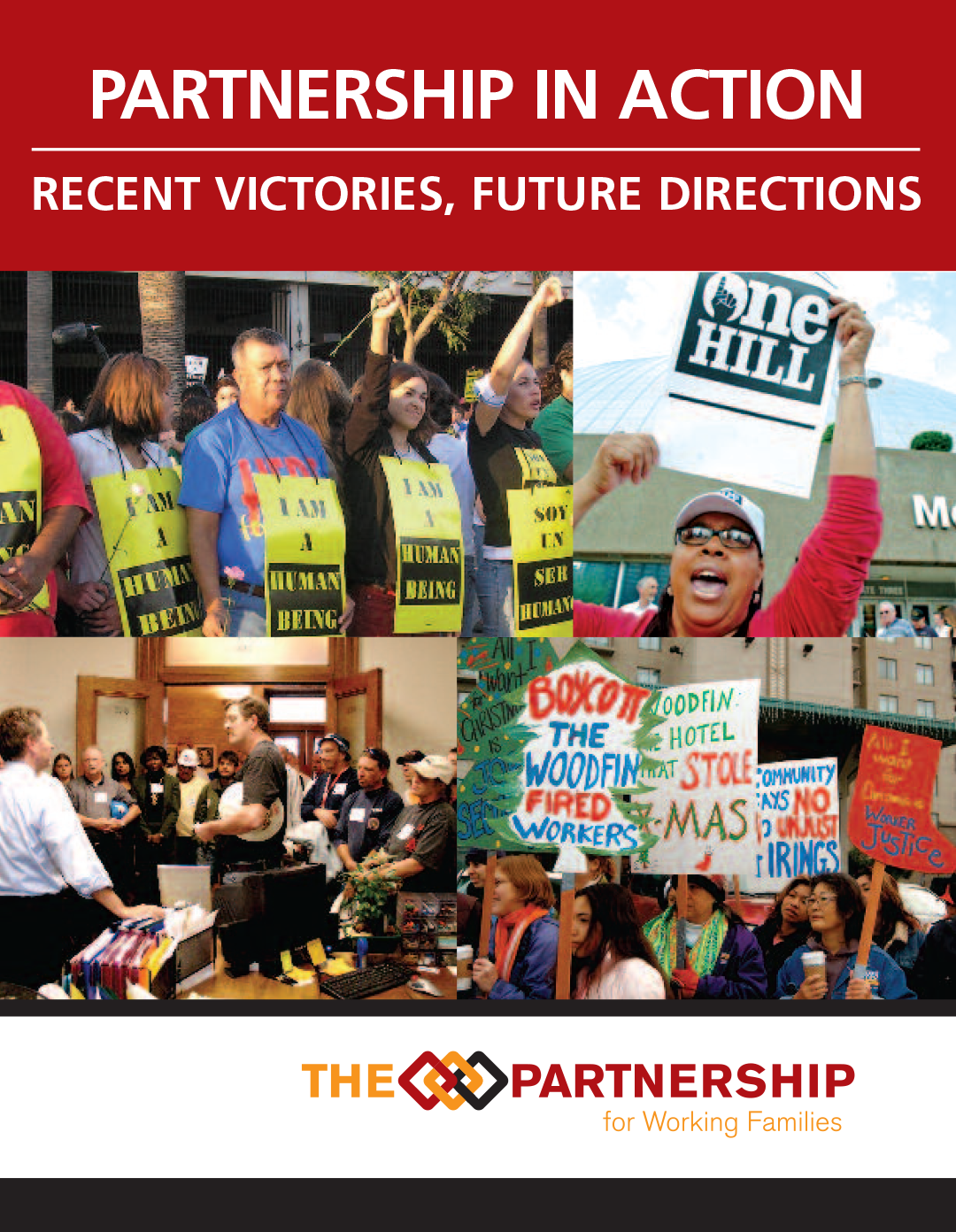report
Building Multiracial Feminist Democracy in the Complexity of California
An Evaluation of PowerSwitch Action's California Program, 2019-2023

Between 2019 and 2023, two external evaluators embedded with a new program that’s been experimenting with ways to weave together PowerSwitch Action’s seven local affiliates in California to grow statewide power for the low-wage workers, people of color, and immigrants who make California run. Here is the report with their findings.
By Rachel Rosner and Eric Wat
Part 1
Introduction
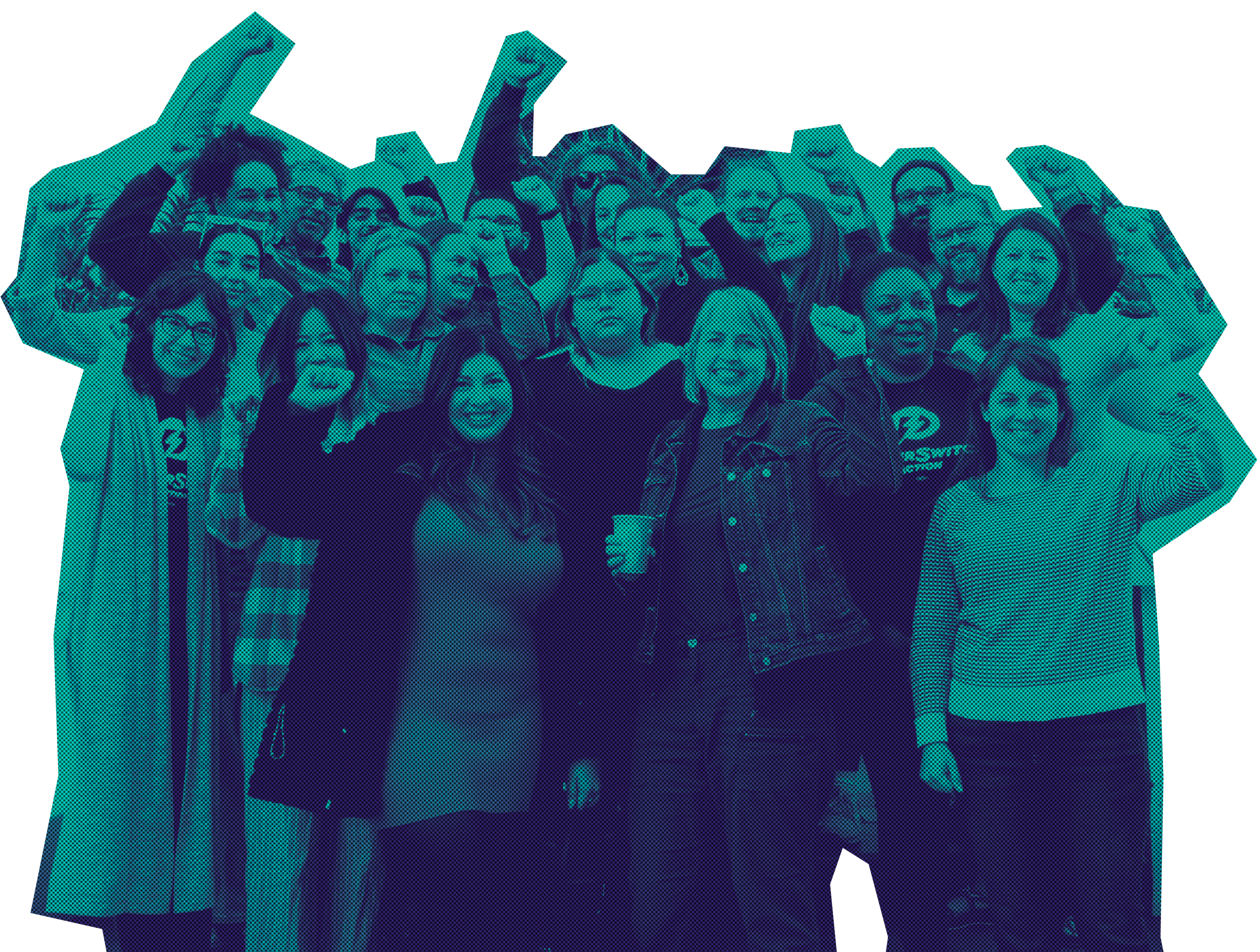
Since 2002, PowerSwitch Action (formerly the Partnership for Working Families), a network of some of the country’s most influential regional advocacy and organizing groups, has been a national leader for building worker power. The network’s bold vision of a people- and planet-centered economy requires fundamentally transforming our democracy and strengthening the voices of everyday people in shaping the economy, government, and public goods in local communities.
In 2017, PowerSwitch set out to create one of the most comprehensive efforts in its history, the California program. As a key program strategy under the network’s long term agenda, the collaboration of the California affiliates aims to build the power of working people to lead innovations for the economic, equity, and climate challenges of the world’s fifth largest economy.
In the early years (2019-2022) of establishing the California program, Rachel Rosner and Eric Wat served as evaluation partners to assess and share what was learned through its development and experimentation. This report (among several other pieces) is the culmination of the multi-year journey alongside the CA program. Three strategic questions emerged from our inquiry and learning:
How can we weave together the interests of working people, immigrants, renters, those living in environmental justice communities, and Black, Indigenous, and People of Color in a deeply intersectional way that recognizes these are often the same people, and results in expanded community power and well-being?
How do we amplify and network local victories to embolden organizing in other geographies and shift the political dynamics of the state beyond what one group can do alone?
How can we target our near-term strategies to achieve transformation that goes beyond incremental improvements?
Exploring these questions elevated three main thematic findings about how the leadership of PowerSwitch Action’s California program makes a difference:
Forging multiracial feminist spaces: To be more strategic and effective, PowerSwitch shapes multiracial feminist spaces for collaboration — like networks or coalitions — that are deeply rooted in building the collective power and shared leadership required for sustainable systems change. This approach contrasts with the many collaborations that set strategy from the top-down and utilize structures and practices that advantage traditionally powerful individual leaders and organizations. Instead, multiracial feminist spaces prioritize structures and practices that address power dynamics, build trust and authentic relationships, and uplift diverse forms of power and leadership. Together, these approaches forge and strengthen the movement infrastructure that is needed today and for the long term.
Crafting braided strategies: Mutually reinforcing strategies create openings and momentum between aligned local victories, statewide campaigns, and national movement building. This multifaceted approach recognizes the need for stronger connections between local organizing and statewide movements to maximize the power building impact of both.
Working from a long term agenda: For immediate demands to create lasting change across geographies and beyond the limits of current politics, they must be connected to an ambitious long term strategy and direction. The network has adopted this approach and brought it to other spaces to move from short term tactical relationships towards long term strategies to transform who holds power.
This report delves deeply into each of these findings. We begin with a brief description of the evaluation purpose, method, and process, and then provide some context for the network development and organizing in the state. The bulk of the report shares the key findings and learnings and looks to the future for emerging opportunities.
Part 2
Evaluation Purpose & Process
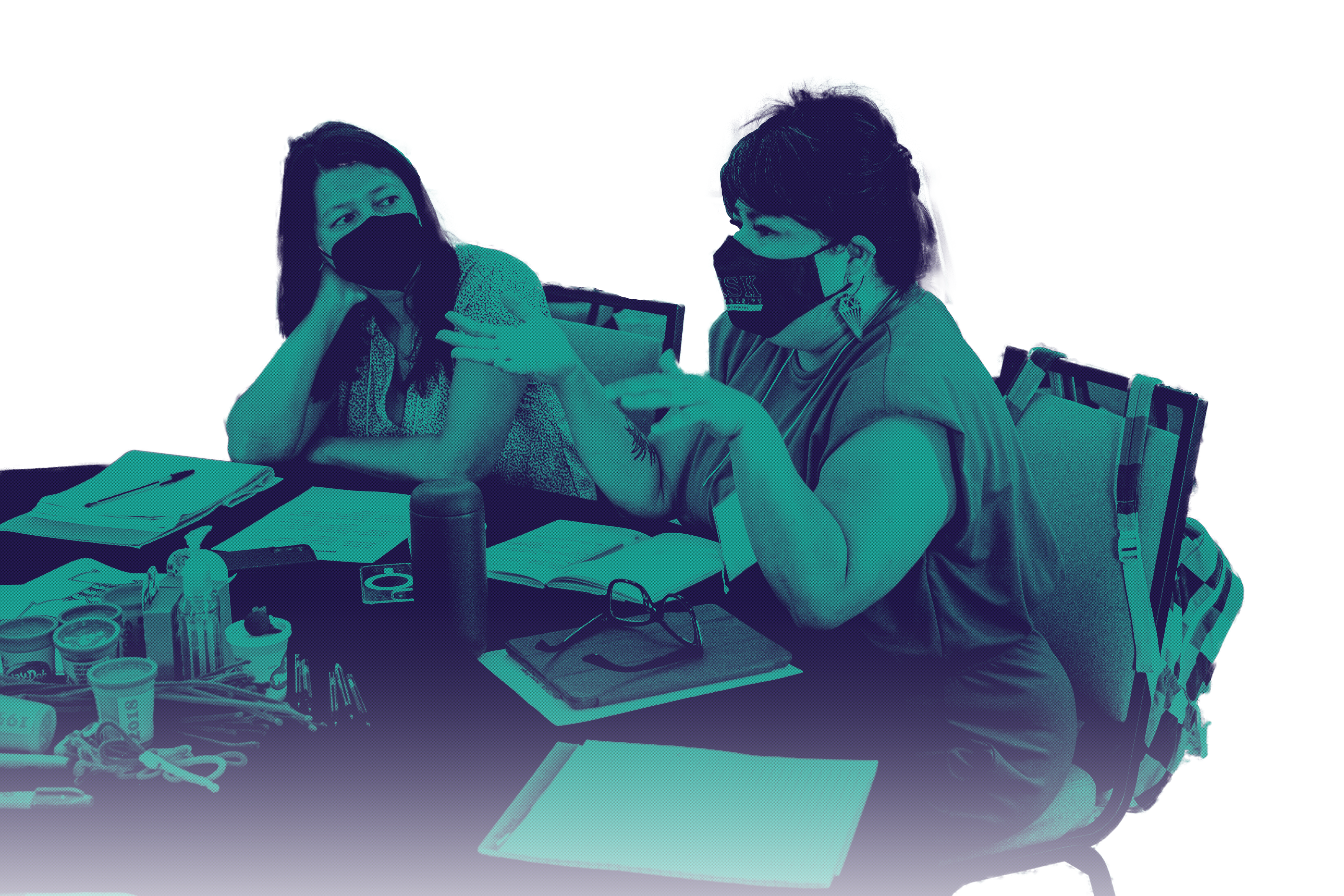
In 2019, with the support of the James Irvine Foundation, we began an evaluative process of PowerSwitch Action’s California program. Using an evaluation framework that considers historical and structural factors, understands how knowledge is generated, and centers equity-based values and practices, we set out to:
Tell the story of the CA program: who is involved, what they are doing, how this is being done, and why that matters.
Lift up, document, and share the program’s progress and learnings.
The overarching purpose of the evaluation was to capture both process and outcomes with the understanding that the network development process is in itself a valued result. As we were in the early years, our findings focus more on the internal aspects that are fundamental to advancing external impacts.
The intended audiences for the evaluative analysis are the PowerSwitch Action affiliates and their allies, funders, and other interested networks or movement builders. Since California mirrors many states, especially red or purple states with blue urban centers, another purpose of the evaluation is to offer learnings about organizing across increasingly diverse places.
Guided by an advisory committee of 12 leaders in the field, we gathered data over three years, reviewed relevant literature, engaged in monthly reflection sessions with the California Director, participated in over a dozen meetings and retreats, analyzed documentation, observed affiliate interviews, and conducted ten key informant interviews. Our first step, after some initial observations and literature review, was to consult with the network affiliates, the advisory group, and CA program staff to develop a set of relevant learning questions. We continued to revisit the learning questions to drive and adjust the evaluation process. Not long after we got started, the COVID-19 pandemic created hardship and shifts in work and health on many levels. Our evaluation process was disrupted and then extended by many months, also requiring only virtual methods for data collection (see Appendix B for more details on methodology).
Part 3
Context for Power Building in California

California occupies a space of critical strategic importance for building the power of working people. In contrast to its image as a wealthy heaven of progressive policy and values, California’s regions contain a vast range of politics and economies, bearing similarities to other populous states like New York, Florida, and Texas.
This diversity makes it possible to test approaches across disparate local conditions within a single state — which has led both conservative and progressive interests to incubate policies and strategies in California for wider replication across the nation. Wins in one part of the state can embolden organizing in other regions and influence change statewide that can result in tangible benefits for all Californians (see below for a longer discussion of braided strategies).
As home to economic output on par with large countries and two recent speakers of the House of Representatives, shifts in power in the state reverberate well beyond it. California is ripe with opportunities to build power not only locally but statewide, demonstrating what is possible in other states and opening doors for national change.
Demographics and Regions
California, the most populous state in the union, has seen increasing racial and ethnic diversity since 1980, with its population almost 40% Latine, 17% Asian, and 7% Black; and almost 19% of residents identify as two or more races. Nearly 44% of households speak a language other than English at home. Income inequality — the gap between low- and high-income families — that has multiplied throughout the country is among the most extreme in California, and wealth is even more unevenly distributed than income.
Diversity is not limited to race or ethnicity; there are also significant geographic and regional differences, such as the more affluent urban coastal metropolises contrasting with the more rural inland, northern, and Central Coast areas, and the more agricultural economies contrasting with the technology focused hubs. Like many states, California has conservative strongholds, such as those in the Central Valley, the Inland Empire, parts of San Diego and Orange counties, and parts of the Central Coast. And these regions are not static, they are shifting due to changing demographics and people being pushed out of urban areas as the real estate industry drives housing prices sky high.
Challenges and Opposition
Despite its national image as the left of the left, California remains what one partner called “a neoliberal hellscape,” with corporate forces driving agendas for the state. The state has deep-seated structural inequities similar to those across the country, holds a long history of conservatism, and is often the incubator for regressive policies that find their way to the national stage.
From 1978’s Proposition 13 that decimated funding for public services to 2020’s Proposition 22 that took away protections for app-based workers, to multiple attacks slated for 2024 (on the ability to raise taxes and fees, enforce labor laws, keep oil and gas wells away from homes and schools, and a narrowly-avoided attempt to undo fast-food worker protections), consolidated corporate power at the ballot box has opened the door for corporations to drive more inequity and labor practices that harm working people.
Corporate interests hold influence over public policies that displace communities or change how “work” is defined. Newer and tech-driven industries (think Amazon and Uber) are changing the nature of employment and are also making it harder for workers to organize. California is of vital strategic importance to a number of the country’s and world’s biggest companies — from Google to Amazon to real estate giant Greystar — tying the fate of the nation to the outcomes of fights in this state.
Corporate interests are pushing back on working people’s gains. Each of the 2020 and 2024 corporate ballot proposals mentioned represents a counterpunch to a recent major campaign to rein in corporate dominance. In Proposition 22, corporate backers utilized the language of equity, leaving 40% of “yes” voters believing they had voted for a living wage for gig workers. Fanning the public’s economic anxieties is another favorite tactic. During the “Great Resignation,” and more recently with inflation, businesses blamed their difficulties recruiting staff on the unemployment safety net and higher minimum wage — ignoring that working people have been making a choice to prioritize their wellness and safety during a pandemic.
Opportunities and Uprisings
Precisely because of the relentless neoliberal assaults in California, the state has also been a site of resistance for activists and communities to hone new organizing strategies. Notably, there have been several statewide power building tables, although prior to the establishment of the California Coalition for Worker Power (more below) none that led with a worker justice lens. There is also growing interest among these formations to collaborate across sectors and issues, through intersectional organizing that understands, for example, how unaffordable housing, low-wage jobs, displacement through gentrification, and environmental injustice are all inextricably linked.
The labor movement has seen an increase in organizing with high-profile action by workers across industries (from Amazon and Starbucks to hotel workers, actors, and screenwriters). Even as California’s union density rises and falls, labor unions play an important role in the state, able to muster significant people power, resources, and political influence. Within the state’s labor movement there is a diversity of approaches: some unions prioritize collaboration with fellow unions and other aligned worker and community organizations, whereas others prioritize services and representation for the base of workers in their own membership. The newer leader at helm of the California Labor Federation is also bringing a new vision and perspective to this institution’s statewide strategy for workers.
Movements for justice more broadly have been pushing for and winning demands that were not politically viable a few years before. Recently, despite some notable losses (such as Proposition 22 described above), there have also been some impressive victories at the ballot box and in legislatures. For example, early pandemic-era advances like eviction moratoria and increased access to paid sick leave were both the result of years of work to shift narratives and build movement capacity to react in moments of crisis. Other significant wins for worker protections and benefits are highlighted below in our findings.
The confluence of conditions in California — a state with diversity in race and regional political economies, corporations driving an agenda of inequality across a breadth of issues, and active contestation for co-governance by people-powered organizations — not only elevated its importance for PowerSwitch but also shaped the strategic questions for the evaluation (shared in the introduction). With neither corporate impacts nor people’s lives isolated to single issues like work, housing, or clean air, PowerSwitch launched its California program grappling with how to coalesce affiliates and allies with sufficient breadth, scale, and vision to meet these challenges.
Part 4
What is PowerSwitch Action?
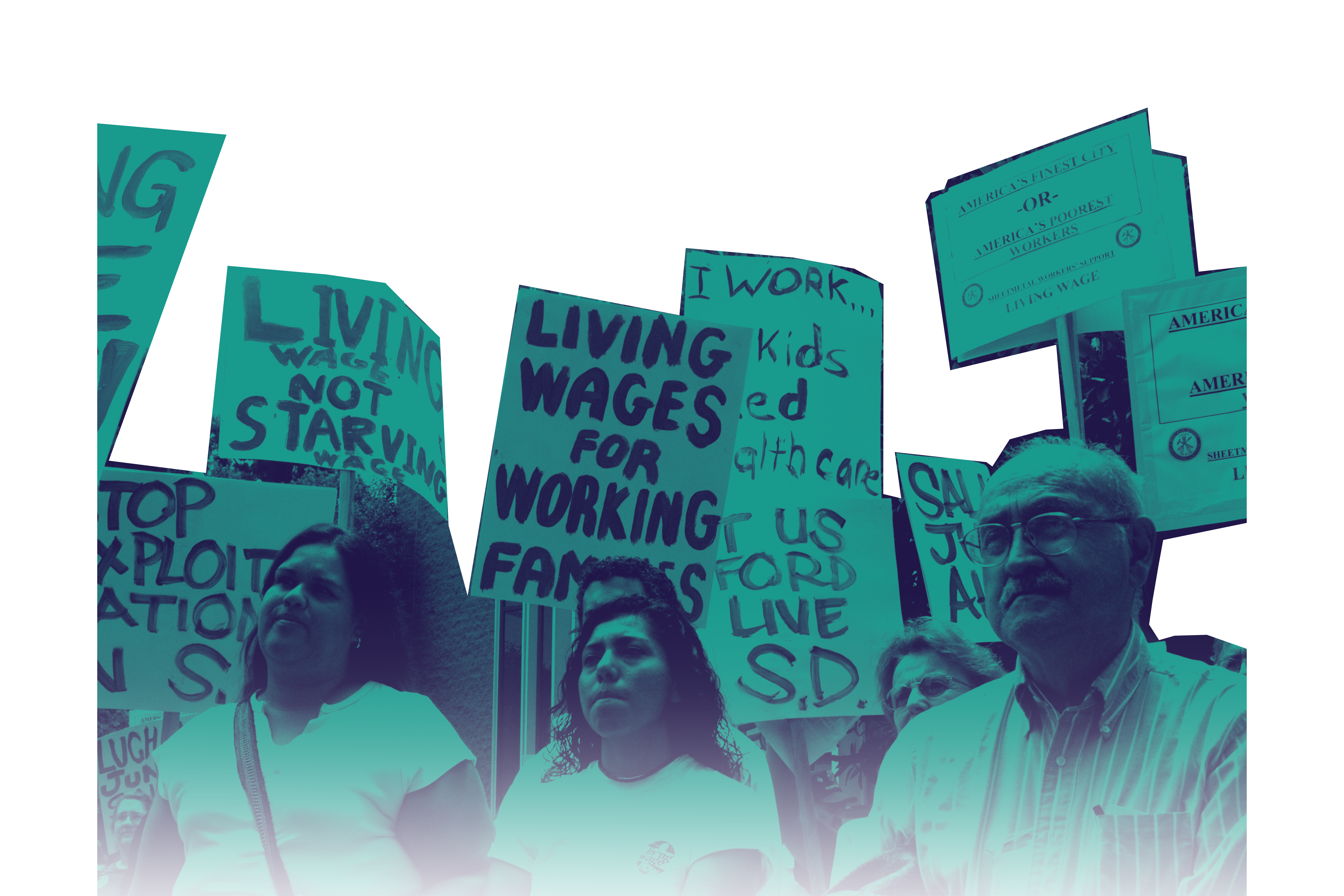
PowerSwitch Action is a national network of 21 grassroots organizations committed to forging multiracial feminist democracy and economies in cities and states across the US. For PowerSwitch, feminist means calling for government that treats care as part of its responsibilities, embracing a more horizontal popular politic, and focusing not just on the workplace but also on neighborhoods, homes, environment and community as part of the political economy.
The network was founded in 2002 when four local California organizations with similar models of weaving labor-community alliances (the Los Angeles Alliance for a New Economy, Working Partnerships USA in San José, the East Bay Alliance for a Sustainable Economy in Oakland, and the Center on Policy Initiatives in San Diego) identified a shared need for an umbrella group that could help them coordinate together. Initially known as the California Partnership for Working Families, the network quickly expanded to include affiliates in New York, Atlanta, Denver, and other cities, and became the national Partnership for Working Families in 2006.
In its early years, the network developed new approaches to leveraging the power of local governments and diverse coalitions to advance economic justice:
Affiliates ran some of the first US campaigns for living wages: pay floors high enough to cover basic necessities, often tied to government’s role as a major employer and client for contracted services. LAANE passed one of the first living wage standards at LAX airport, and other affiliates took the approach to their cities, blazing the trail for its widespread adoption in now well over 120 jurisdictions. This was one of the network’s first experiments with networked campaigns: coordinating across geographies with a shared narrative and often shared issues or targets, and using the lessons and momentum from wins in one place to advance fights elsewhere.
Affiliates and the then-Partnership pioneered the use of community benefits agreements (CBAs): contracts negotiated between real-estate developers and community coalitions that lay out steps developers must take to address local needs (see full definitions in Appendix B). Using a whole people approach (see below), affiliates brought together labor unions and community groups that had historically often been at odds over development projects. With their combined strength, these coalitions were able to win groundbreaking agreements requiring developers to contribute hundreds of millions towards good jobs, affordable housing, childcare, and other priorities identified by residents. As with living wage fights, a networked campaigning approach helped spread the adoption of CBAs across the country, and such agreements are now frequently part of major developments (particularly those on public land or receiving public subsidies).
Recognizing a need to act more boldly to meet the challenges of growing authoritarianism and a planet on the brink, leaders from across the network embarked on a multi-year visioning and planning process in 2017. This led to the 2021 launch of a long term agenda for creating a people-and planet-centered economy, guided by four interwoven core strategies (see graphic). With this launch, the network rebranded as PowerSwitch Action to more fully reflect their work and the future they envision.
The core strategic imperatives developed through PowerSwitch Action's long term agenda process:
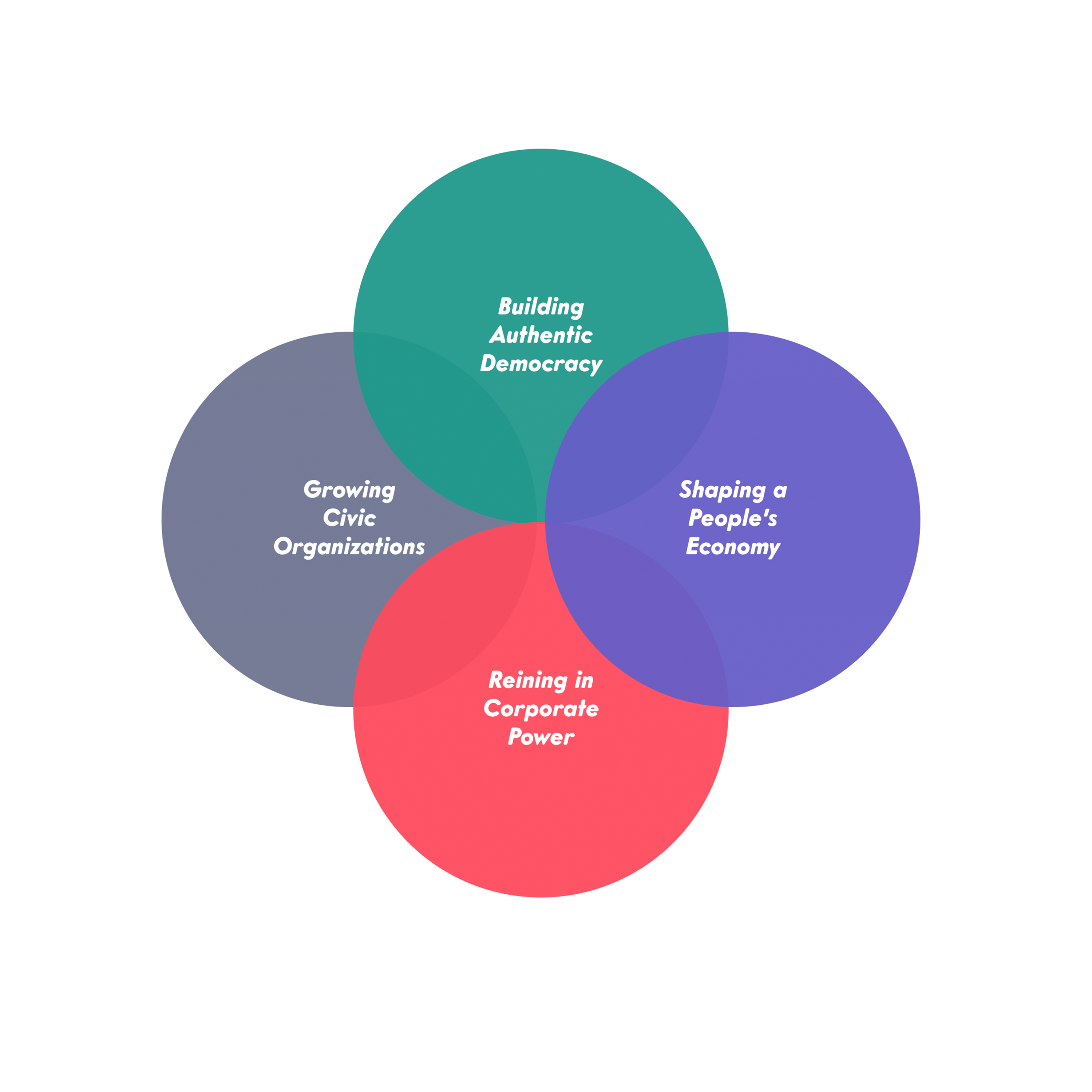
How do California Affiliates Move Together?
The California program seeks to build worker power and organizing for a broader set of shared goals while pushing back on corporate power and strengthening co-governance in regions and the state. It envisions democracy that is both multiracial and feminist, where people govern and steward labor and land toward a regenerative economy — one for the many, not the few. The shared work of the PowerSwitch affiliates in California is based on some fundamental strategic values and analyses:
The power of workers can be a keystone in the broader movement to shift our political economy toward racial, gender, and climate justice.
To tap into this power, workers must be organized as whole people through strategies that lie at the intersections of identities and issues (see box below).
Network building must better connect to base building and organizing, not only policy advocacy.
A networked approach is essential for the affiliates to bolster each other’s local organizing while moving together to build collective worker power statewide in a way that honors the unique political history and reality of each region.
Working people must directly engage with corporate interests, not only with government decision-makers who are at times a proxy in the fight with corporations.
The "Whole People" Approach
There is a tendency to think in terms of single identities and issues: however, the same workers that are paid low wages are likely renters struggling with landlords hiking rents, living in frontline communities dealing with climate change and industrial pollution, and immigrant communities threatened with being reported to ICE if they speak up.
In reality, the same communities are at the core of these overlapping identities and a key part of the approach is to bring together broad coalitions that unite across issue areas to build power where the whole is greater than the sum of the parts.
A “whole people” approach is holistic, encompasses intersecting identities, and is grounded in the fundamental analysis that economic extraction from people whose labor drives our economy is at the core of all these issues.
Internal Network Building
The California program’s strengths can be characterized as building internal capacity through its network development and building external power through campaigns and strategic leadership beyond the network. Up to the writing of this evaluation report, the start-up phase of the California program was more focused on internal foundational work. Though this work continues to evolve, the future emphasis is on externally shifting power in the state and experimenting with the interplay of local and statewide power.
In this formative phase, solidifying and aligning the seven affiliates' shared purpose has been central to the program’s development. One of the CA program’s greatest assets has been having a strong shared analysis and understanding of economic, social, and political conditions and trends (both historical and forward looking). The program and affiliate staff are continuously refining and applying this analysis to sharpen their aligned strategies, both demonstrating the value of aligning affiliates’ interests and sustaining their engagement. With PowerSwitch Action’s support, the affiliates have found a trusted political home. It is a space where they can deepen relationships, share tools, and brainstorm organizing strategies to advance their work within and beyond the PowerSwitch network. Having this common ground creates a learning community and allows for faster action when the landscape shifts (such as during a crisis).
In October 2018, PowerSwitch added its first position allocated full-time to the CA program. Today, there are three full-time staff dedicated to the California program, as well as leadership from across the organization on strategy, communications, campaigns, development, finance, and operations. PowerSwitch, recognizing that the fundamentals of the political economy have shifted during the lifespan of its organization and network, has moved to a more integrated organizational and organizing structure. It has both function-focused and cross-cutting teams bringing together staff with a range of expertise to carry out campaigns and programs.
PowerSwitch’s centralized resources help affiliates move together to manage both regional and statewide work more effectively. Its approach has evolved from mostly providing technical assistance to affiliates and the network to supporting and aligning networked campaigning. Staff support the affiliates and network through shared learning, coordinating strategies among affiliates, and providing technical assistance (such as industry research, policy analysis, convening, and communications). They are also positioned to support affiliates as they take on more base building. Perhaps most importantly, they watch for and seek to open up opportunities to advance toward bigger wins.
Internal network building has impacts beyond those facilitated by network staff or contained within shared campaigns. Affiliates regularly draw upon their deep alignment and authentic relationships to strengthen their local work through methods such as joint fundraising or swapping intelligence and insights on the political dynamics shaping state policy implementation and resource allocation in their respective regions. At the start of the pandemic, when affiliates were on the frontlines of fighting for local protections like paid sick leave, eviction moratoria, right to return to jobs after layoffs, and relief for undocumented workers with no unemployment benefits, they collaborated with each other directly — not requiring network staff support — to track the status of various policies, study models, share campaign lessons, conduct coordinated actions, identify opportunities to develop shared demands, and build coalitions for state level policy. In addition to building these collaborations, affiliates also apply lessons and strategic orientations from each other to local campaign work.
For example, though the Center on Policy Initiatives is not part of PowerSwitch’s Housing and Land Justice cohort, when their education justice campaign offered an opportunity to address teacher housing, their lessons from the network led them to expand the approach to benefit the broader community of low-income tenants and to include elements of community stewardship of land.
"The California program is an extension of ourselves, kind of like family. We can have real talk."
- CA Affiliate
"One of the reasons I think that the network is so important is because it allows groups to share information and support each other in their experimentation that allows innovation to spread. More learning, more backup when people run into issues.”
- CA Partner
External Network Connecting
Connecting as a network creates a vehicle through which the affiliates can flex their collective local power to move networked campaigns on translocal, state, or even federal levels. To do this, PowerSwitch’s support extends well beyond internal network building. The California program staff are seen as vital links between unions, community-based organizations, and other formations.
In addition to taking on leadership positions at diverse tables, the California staff are often asked to serve as connectors, helping to facilitate difficult conversations and negotiate power amongst stakeholders. This requires a significant investment in and management of relationships, perspectives, and strategies in a demanding political environment — and is considered to be a valuable capacity and role in the ecosystem. In the next section, we will explain more about what this looks like in practice, including PowerSwitch’s role and impact.
"I think PowerSwitch, in a short amount of time, has played such a key anchor role in movement power building. Because of the strategic work that they do across the state with their affiliates, they're being invited to sit at the larger tables. They did that in four years, that's an incredible feat.
That goes to Elly (the CA Director)’s leadership and how she shows up in the world, that it's both created greater alignment and greater synergy in this worker justice ecosystem. And that's translating to this larger progressive movement."
- Foundation Partner
Part 5
Findings & Learnings
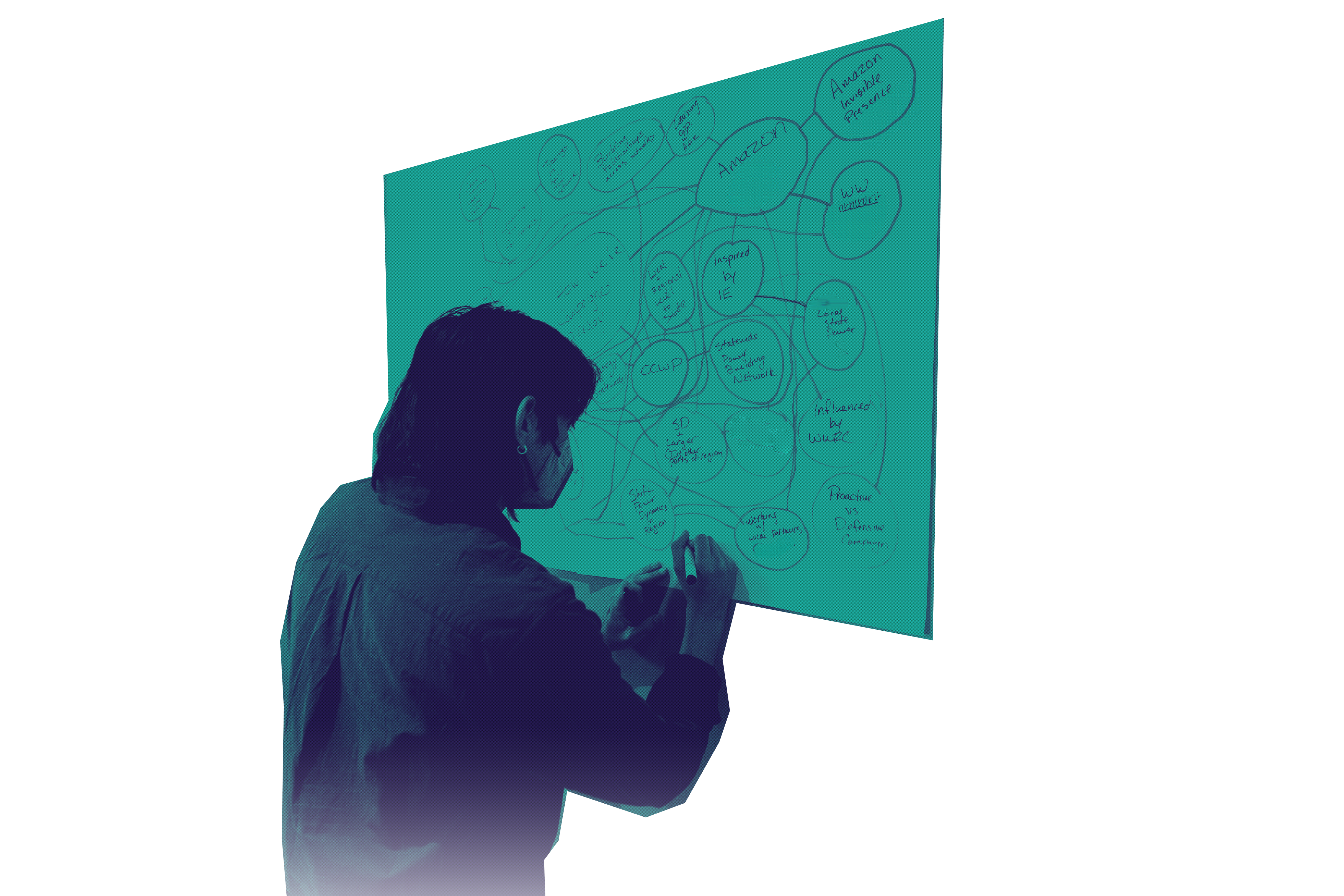
The previous section gave some context describing what PowerSwitch is and how the network moves together. Now, we turn to what they have done together and how it was accomplished. Our learning questions — which explored ways of addressing intersectional power building, amplifying the impact of the network, and advancing transformational change — unearthed three interrelated elements where PowerSwitch has made significant contributions to the field. We describe these below, followed by examples of how they were applied at two statewide tables.
Forging Multiracial Feminist Spaces
Our interviews revealed that the leadership approach of PowerSwitch’s California team is valued, respected, and recognized as an important and impactful contribution to the movement. PowerSwitch has intentionally developed a model for shaping and managing power building spaces (such as campaign coalitions, statewide tables, and the network of California affiliates) in a multiracial and feminist way.
This model is undergirded by an analysis that coalitional movement work has often been hindered by top-down leadership practices that may work in corporate or military contexts, but which are ill-suited for aligning and sustaining alliances that draw power from a diverse set of constituencies and organizing approaches. The default for statewide and national efforts focused on cities is typically to create cookie-cutter models of local policies or campaigns and then expect local groups to run them, or the state or national campaigns create conditions on the ground that are detrimental to local power building. These might achieve quick easy wins, but since they don’t meaningfully tap into the power of local organizations and their allies, they rarely address root causes or set up bigger future victories. Moreover, approaches that fail to equitably manage power dynamics and surface shared wisdom frequently lead to fractured alliances, transactional relationships, ineffective strategy, and little lasting success.
Since weaving coalitions and coordinating among autonomous local affiliates are core to PowerSwitch’s work, the team takes a systems leadership approach. Grounding in trusted relationships and alliances allows them to work together more effectively, and when necessary (like during a crisis such as the pandemic), it allows them to move forward in sync without having to run every decision through the full network.
PowerSwitch focuses on relationship building for longer term systems change, broadens leadership definitions to recognize a broader spectrum of styles and contributions, and relies on collaborative approaches. This approach:
Develops structures and practices to sustain lasting alliances. By explicitly considering power dynamics, PowerSwitch helps manage the challenges that often tear apart coalitions, such as raising funds, setting strategy, and taking credit. This is especially critical when some partners come to the table with more resources, political power, and experience than others. As described in the case studies below, PowerSwitch has guided coalitions to consider these issues and devise structures to hold the tensions. It has structured its own network with similar considerations in mind, such as by having a board of directors comprised entirely of affiliate leaders. The staff have also led work to develop clear, transparent, and intentional processes that support access and appropriate engagement, such as agreements around how decisions will be made and conflicts worked through.
Emphasizes trust and authentic relationships. PowerSwitch recognizes that building trusting relationships between leaders from different backgrounds and organizations helps create the conditions for effectively developing strategy and addressing conflict before it gets toxic. To that end, PowerSwitch runs a Transformational Leadership program that trains staff and affiliate leaders in skills and techniques for connecting authentically, having difficult conversations, and grounding in shared values. PowerSwitch incorporates these practices into its coalition work and supports partners in implementing them as well.
Lifts up and leverages diverse forms of power and leadership. It recognizes that leaders are not always the loudest voices at the forefront, that the work that sustains coalitions and movements often happens behind the scenes, that shared leadership will take the work further than relying on charismatic individuals, and that the smartest person in the room is the collective. By prioritizing relationships and noting that different individuals and organizations bring different assets to the table, this approach builds a bigger bench. It brings more power, especially by equitably engaging organizations that are smaller, have less funding, are led by BIPOC and gender-oppressed folks, and emphasize developing small but deeply engaged bases in local geographies. It also brings more voices (especially those of people of color and gender-oppressed folks) into decision making, making our movements more inclusive, authentic, strategic, and effective.
In addition to sustaining effective coalitions, this approach brings a number of additional benefits. Appreciating whole people as they show up in movement spaces encourages building bridges between diverse communities and sectors. Valuing collectivity and being open to change, vulnerability, and reflection promotes learning and emergent strategies. And creating moments where people (especially those who have been excluded from leadership) can engage in equitable decision making provides lived experience doing something different and difficult, but very rewarding — building a vital muscle for the network’s north star of multiracial feminist democracy.
Crafting Braided Strategies
The way PowerSwitch Action leads is reinforced by its interwoven strategies. In contrast to more siloed, issue-specific, or geographic-based organizations, the PowerSwitch California program ties together issues and places. Supporting bi- or multi-directional approaches rather than more singular or disconnected ones, the network is positioned to bridge between local, translocal, and statehouse-focused campaigns through mutually reinforcing strategies and capacities. This method creates what the program calls “braided strategy,” where strands combine to form a stronger, more impactful, and more sustainable force than any individual thread.
These mutually beneficial strategies reinforce each other with shared narratives, enabling the alignment of local strategies across vastly different political and economic dynamics. Statewide wins can be used to bolster local organizing, and statewide campaigns can draft off of local power and organizing. For example, in advocating for state-level policy change that is too challenging or too inefficient for any one local affiliate to take on alone, the braided strategy allows multiple affiliates to “roll up” their local victories to change the political discourse at the state-level about what is possible and to influence legislation and policies in a way that benefits multiple locales. At the same time, statewide and national campaigns help to create beneficial conditions for local power building by shifting narratives, changing policy, providing funding, and helping to create new venues for local leaders to exercise leadership and exert influence.
Braided strategies also reinforce the larger goal of the California program to build a more connected and powerful network — as additional threads are added, the braid grows stronger. This requires alignment among the regional affiliates so that as a network, they can be nimble and responsive to quickly evolving political realities. California program staff play multiple roles by supporting peer learning, identifying emerging opportunities for bigger and quicker wins, and coordinating strategies and communication at both local and statewide levels.
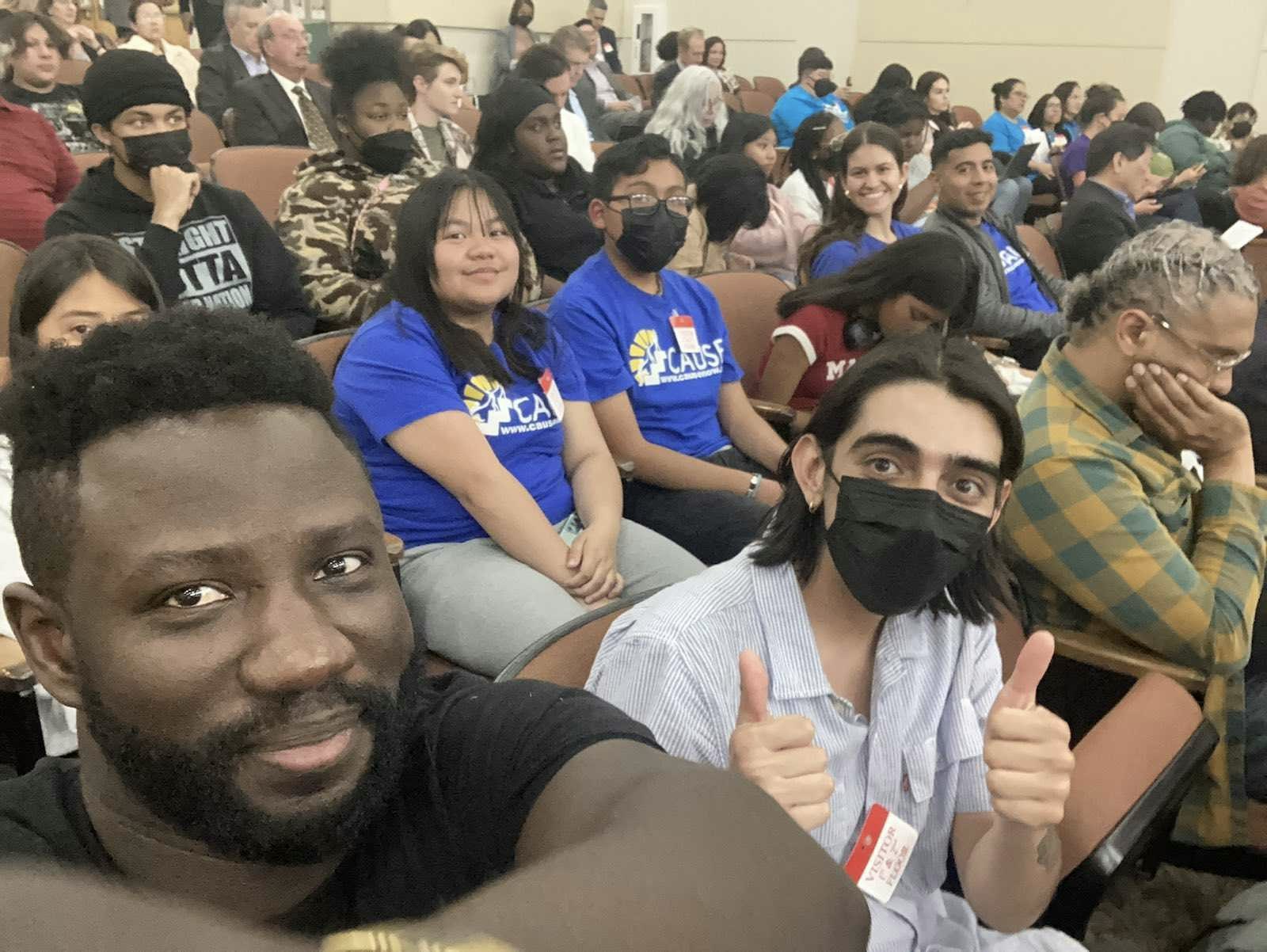
The following example demonstrates how a braided strategy has contributed to local and statewide successes:
In Southern California, PowerSwitch Action affiliates the Center on Policy Initiatives (CPI), Los Angeles Alliance for a New Economy (LAANE), and Central Coast Alliance United for a Sustainable Economy (CAUSE) have leveraged local governments in different port authorities and air quality management districts to move toward regenerative economies around their local ports.
The three affiliates have had long-standing campaigns at the ports of San Diego, Long Beach, Los Angeles, and Hueneme. They’ve organized with bases of local workers, environmental justice communities, and allies to decarbonize ports and associated trucking while protecting workers (especially misclassified truck drivers) and maximizing the benefits to local environmental justice communities.
A fourth affiliate in the Inland Empire, Warehouse Worker Resource Center (WWRC), has been working locally to transition its warehouse and logistics infrastructure toward zero emissions, including forming a partnership with high-road employers to develop the workforce of technicians that will be able to repair and maintain zero-emission trucks.
Over the last few years, these efforts have come together with the affiliates working through PowerSwitch Action and a broad coalition of labor, environmental, and environmental justice allies to pass statewide regulations (the Advanced Clean Trucks and Advanced Clean Fleets rules in 2020 and 2023, respectively) that set a deadline for California’s heavy duty trucks to transition to zero emissions, while building in worker protections.
PowerSwitch Action brought local warehouse workers, truck drivers, and youth in environmental justice communities to testify before regulators in support of these regulations. Now, the affiliates and their local bases will leverage these state regulations to advance local campaigns, pushing their local ports to implement strong policies for decarbonization, benefits to environmental justice communities, and worker protections.
Working from a Long Term Agenda
For immediate policy and corporate campaigns to create lasting change across geographies and beyond the limits of current politics, there have to be shifts in power that move beyond short term tactical wins and transactional relationships. As PowerSwitch Action knits together networked campaigns, it is guided by the network’s long term agenda to contest corporate power and advance multiracial feminist democracy. To shift more power to working people, PowerSwitch Action carefully crafts campaigns that disrupt the status quo, helping to make corporations contend with the people most affected by corporate practices demanding safer working conditions, improved wages and benefits, and more healthy and vibrant communities.
For a long term agenda to bear fruit, organizations must not only adopt long term goals and strategic pathways to pursue them but shift the way that they work. Rather than choosing near term goals and campaigns based on what is winnable given current conditions, working from a long term agenda means naming the reforms that could achieve deeper structural transformation, then identifying the conditions that would be required to make these reforms possible, and then prioritizing interventions that could create these conditions — even if those interventions do not constitute wins as conventionally conceived, such as passing legislation.
Crafting interventions to move the needle on conditions — and make possible bigger change and wins tomorrow than are achievable today — requires various capacities, such as:
Deeply investing in leadership development so that campaigns bring forward new leaders that reflect the vision and diversity of the movement.
Conducting research in order to ground their strategies in an understanding of specific leverage or reforms to move a target (like a divestment campaign) that may be out of reach now but could have high impact with new conditions, such as building a coalition with major influence on investors.
Using multifaceted communications and narrative strategies that not only support campaign goals, but do so in ways that expose corporate malfeasance and show what’s possible when communities come together to win innovative solutions (rather than inadvertently reinforcing popular oppositions narratives about individualism and scarcity).
PowerSwitch has adopted this long term agenda as a network and brought it to coalition spaces for organizing, campaigning, and collaboration. The staff have been described as “systems thinkers and leaders,” able to foster collective leadership, see what long term change looks like, and understand what is required to get there. Keeping the eye on the long term agenda gives direction and guideposts, while offering an alternative vision for a more equitable future for workers.
PowerSwitch in Two Statewide Coalitions
As observed during the evaluation period, the California program and its affiliates have played significant movement roles and impacted statewide tables by applying these approaches and strategies. The following two examples describe how they provided the sweat equity to transform, organize, and lead — with some exciting results.
Safety Net For All
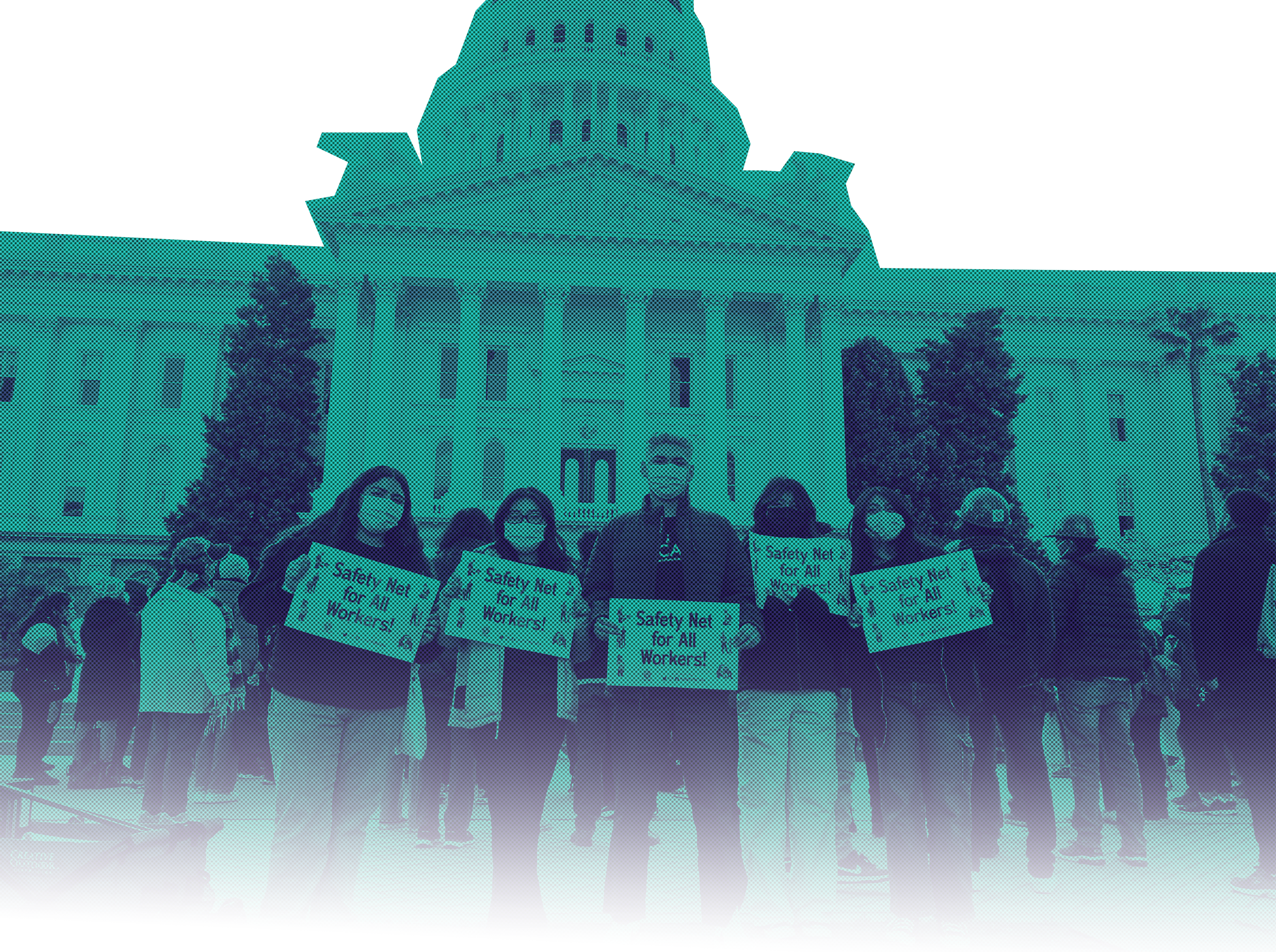
At the start of the pandemic, there was a coming together of groups to address the drastic changes for workers. Safety Net for All (SN4A), a statewide coalition of immigrant and worker rights organizations, emerged to campaign for excluded immigrant workers. The coalition — co-founded by a number of worker and immigrant organizations, including PowerSwitch Action, its affiliates, and members of the California Coalition for Worker Power (see below) — demanded relief for undocumented workers who were not eligible for unemployment benefits and federal stimulus.
The pandemic made these already vulnerable workers more insecure: without an unemployment safety net, undocumented workers who spoke up and advocated for their rights risked losing everything if their boss fired them in retaliation. To add to their losses, employers were cutting hours or jobs for immigrant workers at rates far exceeding those for other workers. Organizing led by SN4A and others in the philanthropic community and beyond won the 2020 Disaster Relief Assistance for Immigrants program as well as the inclusion of excluded workers in the 2021 Golden State Stimulus. The latter victory infused $770 million into undocumented families’ pocketbooks.
With leadership from PowerSwitch affiliates and staff, the coalition moved early on to commit to a vision beyond near term relief, defining its purpose instead as achieving long term structural change: a permanent system of unemployment benefits. Additionally, the coalition recognized that the directly impacted workers taking leadership included not only those who had lost work but those still working under hazardous conditions who could not leave or speak out to their employers without fear of putting their family’s survival on the line. Thus the coalition saw its demand for unemployment benefits as being about not only economic need but also the power of immigrant workers to require employers to respect their basic rights. Fundamentally, it was a demand that immigrant workers’ human worth and ability to survive should not be conditioned on the whims of an employer.
In the pressure cooker of the pandemic, PowerSwitch staff and affiliates also ensured that the coalition’s relationships and systems grew to support its campaigning. They initiated the co-creation of resource sharing principles and shaped fundraising and strategic plans, ultimately spearheading the coalition’s successful pursuit of its first grant. They also helped form a leadership structure that put directly affected workers at the helm of the campaign and gave them the capacity to navigate the race and class diversity within the coalition itself.
With these practices and infrastructure in place to support the coalition beyond a crisis response, the California program’s staff stepped down from its coordinating committee role in 2022. Allies and the affiliates expanded their leadership, with SN4A achieving increasing progress in the legislature in 2022 and 2023 for a program piloting unemployment benefits for excluded workers.
California Coalition for Worker Power

The California Coalition for Worker Power (CCWP) is an unprecedented alliance of worker centers, worker advocates, labor policy experts, and labor unions aiming to dramatically scale worker organizing and drive at the root causes of insecure work. The coalition is another example of how PowerSwitch Action and its affiliates brought values, strategies, and capacities to impact a statewide table
CCWP is an example of how we have to learn to work together better to tackle these big issues. We need to develop the muscles and spaces to not only come together around a bill, but to develop long term alignment.
- Lauren Jacobs, Executive Director of PowerSwitch Action
The coalition is the result of years of relationship building, organizing, and experimenting. PowerSwitch Action staff played an instrumental role in the merger between the California Alliance for Secure Employment (CASE) and the Future of Workers and Work (FOWW), the precursor to CCWP. They continue to lead collaboratively and provide behind-the-scenes support. Currently, the executive director of a PowerSwitch affiliate serves as a co-chair for this statewide table, and affiliates serve on its coordinating committee, organizing committee, campaign committee, and in leadership roles with fundraising and the organizing institute. PowerSwitch also administers funding for about half of the coalition’s budget, houses one of the dedicated staff positions, and staff serve as co-managing director, fundraising co-chair, and coordinating committee member.
Generally, PowerSwitch affiliates and staff strategically pivoted between serving as convenors to connect different partners, and as advocates to push the coalition to embody a multiracial feminist approach. This required running the coalition in ways that built and centered relationships and navigating partners with different capacities and organizing cultures. Specifically, they led on:
Establishing and engaging others to create a transparent and intentional structure.
Approaching the near term priorities with a long term orientation (building a long term agenda).
Shaping an analysis around the role of corporate power.
Developing equity-oriented and transparent resource sharing principles for the coalition.
Practicing intentional and generative approaches to conflict.
Fundraising.
In the early weeks of the pandemic, the merged coalition created a COVID-19 resource clearinghouse to support workers during COVID. In 2020, CCWP played a key role in CalOSHA's temporary emergency standards for COVID, and CCWP members led efforts to create Public Health Councils and an anti-retaliation ordinance in LA County. In 2021, they successfully pushed for the passage of AB 3075, which prevents employers from reincorporating their businesses under new names to avoid paying outstanding wage judgments owed to their workers.
"During COVID there was still a hunger for CCWP. I thought people would turn inward, but they saw we didn’t have a coherent strategy. There were mumblings about austerity with COVID, so we were getting ready for that and we saw the need for a statewide response."
- Sheheryar Kaoosji, Executive Director of WWRC and co-chair of CCWP
After months of coalition building, lobbying, budget advocacy meetings, mobilizing, collecting stories, and testifying at hearings, the coalition secured $71 million to support workers’ freedom to organize in 2022. This included $21 million to triple the capacity of the Retaliation Complaint Investigation Unit, and $50 million to maintain and expand the workers’ rights education programs established under the California COVID-19 Workplace Outreach Project (CWOP), which funds community organizations that go to workplaces to educate workers about their rights and protections on the job. The funds were threatened for elimination in the Governor’s January proposal for the 2023 budget, but CCWP successfully advocated to protect the funding while aligning allies towards transitioning the project into a permanent program within the California Labor and Workforce Development Agency as part of a long term strategic enforcement agenda.
Even with these accomplishments, this work is, in many ways, just the beginning. When CCWP asked its members what issue could have the greatest impact on scaling organizing, the response was ending retaliation. Retaliation against worker leaders is unfortunately all too common, and keeps workers from organizing or raising workplace issues. Retaliation weakens every labor law because workers are afraid to enforce their rights. Based on this prioritization, CCWP started the Our Voice, Our Jobs (OVOJ) campaign to win state level protections against retaliation for workers who speak up. The vision is to ensure that retaliation is no longer a determining factor in whether organizing campaigns succeed and that a secure employment policy paired with effective enforcement will protect workers from arbitrary and unfair firings. One such example is “just cause” policy, which establishes that an employer must show that there is a justifiable reason for firing a worker. OVOJ shines the light on the pervasiveness of retaliation, making the case and creating momentum for state level legislative fights. Winning stronger protections will make it harder to use retaliation to squelch worker organizing, and thus hold corporations more accountable. OVOJ’s first victory since its launch is the 2023 passage of the Equal Pay and Anti-Retaliation Act, making it easier for workers who speak out about wage theft or equal pay violations to hold employers accountable for unlawful retaliation.
PowerSwitch Action and its affiliates play pivotal roles in statewide initiatives far beyond CCWP and SN4A. This includes serving in leadership roles for the California Power Building Infrastructure Center (I-Center), a field-led initiative to build infrastructure for the state’s power building organizations, as well as on the North Star Committee, an effort to align movement organizations to win key structural reforms in California. Being invited to these tables and taking on leadership roles signal their growing influence in the state.
Part 6
Current Networked Campaigns
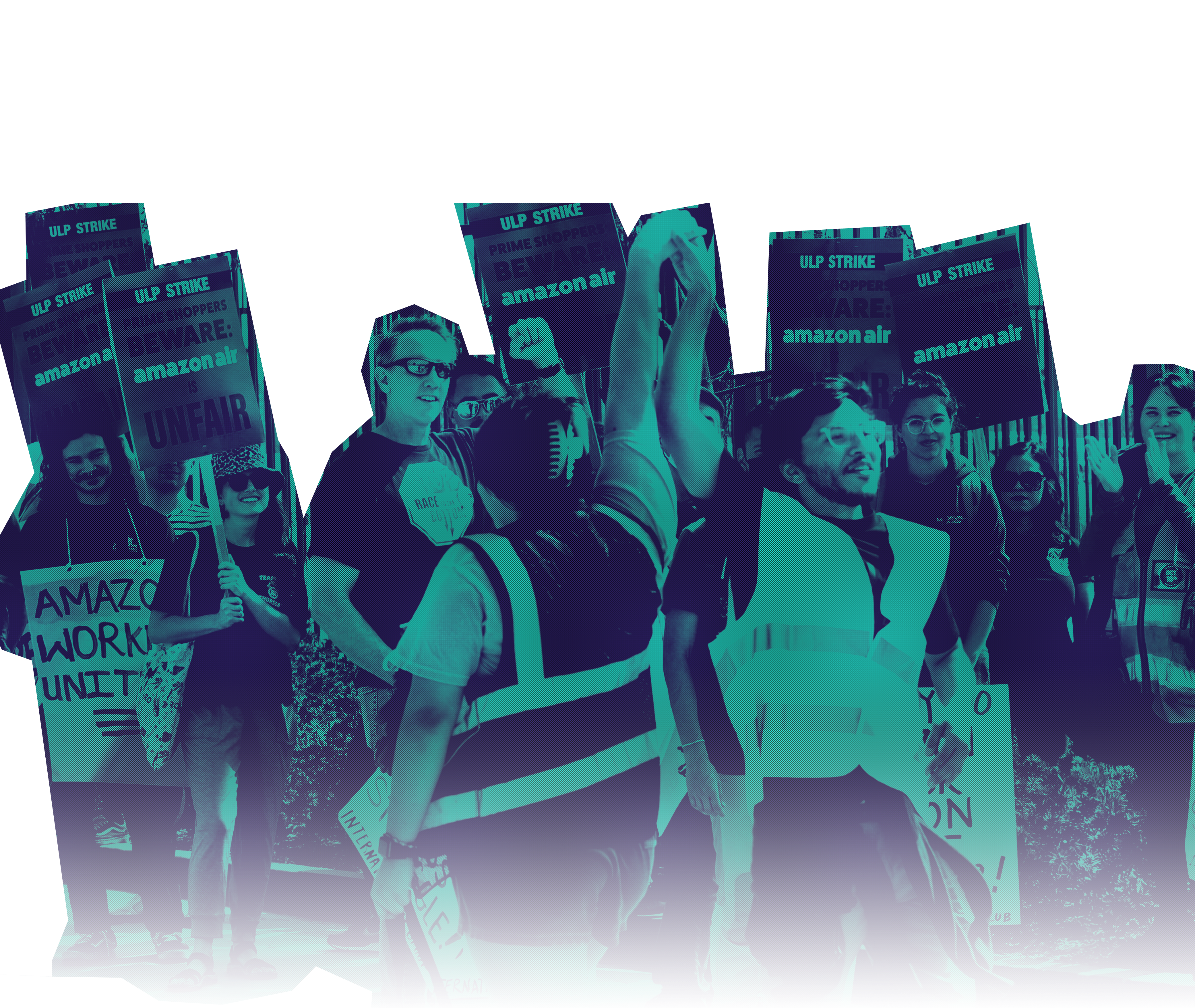
Here we describe two current networked campaigns on the cutting edge of PowerSwitch’s organizing in California. With these, the CA program and affiliates are working on shared goals and policies with a shared umbrella narrative, while organizing on a single or multiple issues in different places at different times.
Through this approach, the network is engaging in a series of local campaigns across the state to build momentum toward bigger wins. The first networked campaign we explore is an intentional statewide (and national) strategy to rein in the most abusive practices of the logistics giant Amazon. The other connects housing efforts statewide.
Amazon
Amazon touches virtually all aspects of our economy, communities, and democracy, impacting everything from job quality and the environment to public surveillance, land use, and public revenues. Amazon’s influence on regional economies also gives the corporation significant sway with local elected officials. The presence of an Amazon site dramatically changes local economic and housing patterns and contributes to larger environmental degradation. Yet many cities have welcomed the Amazon facilities as development opportunities — while overlooking the damaging effects on their communities and residents.
Beyond this pattern of local impacts, Amazon’s role as a giant player across multiple sectors is fast reshaping how we shop, how we work and do business, how we live in communities, and how we are surveilled and policed. It is a main sales platform — and competitor — for hundreds of thousands of small businesses and content creators. It runs the world’s largest network of cloud services and other vital communications infrastructure technologies, including those undergirding essential government functions, as well as non-essential ones, such as immigration enforcement. Amazon’s direct control over markets allows it to punish millions of individuals and companies almost at will, as it did when it cut off sales by the book publisher Hachee in 2015. Amazon is now moving fast into the business of “managing” purchases by city and state governments, and even those of the Pentagon in Washington, giving it new and direct power over public, local, and national officials as well as public dollars. Amazon has built a spy system that assembles vast troves of secrets on the interests, actions, and political leanings of almost every American. As such, Amazon embodies (perhaps more than any other corporation today) the threat that massive concentration of wealth and political power present to both democracy and an economy for the many, not the few.
Due to its national profile and geostrategic location, California is a critical space in which to bring Amazon to heel. The megacorporation is ever-present in different regions of the state with dozens of import, distribution, fulfillment, and transportation facilities. In fact, Amazon is California’s largest private employer with over 150,000 employees. And while its business practices make it more challenging for workers to organize, Amazon also presents opportunities for linking across industries on local, state, and national levels through the goods movement (distribution, retail, logistics) and other sectors (particularly cloud computing and digital surveillance). Home to the ports that handle over 40% of all goods entering the contiguous United States, including the largest port in the country, California is key to the goods movement across the nation.
A campaign engaging Amazon is a good match for PowerSwitch’s strengths, approaches, and long term agenda. Taking on Amazon is clearly connected to the fight to contest corporate power, to the larger struggle against threats to democracy, and for the future of the planet. It also centers workers and builds power among the most impacted. The multilayered scale gives PowerSwitch a chance to flex its muscles around the braided strategy — with local campaigns creating statewide momentum and establishing state policies that couldn’t be won at the local level. Getting beyond traditional issue-area silos by connecting workers’ rights, environmental justice, housing, surveillance, and more also opens up the potential to connect worker organizing with policy efforts that call into question Amazon's unchecked growth and insist on greater accountability. By aligning across multiple issues, strategies, and geographies, the campaign has the potential to build a more diverse, powerful, and robust worker movement.
Power Building and Policy
PowerSwitch Action has been a leader in campaigning in multiple states and localities to transform Amazon's impact on workers and communities, both through its own campaigns and as a co-founder and core leader of Athena — a broad coalition of local and national organizations representing working people, small business owners, people of color, immigrants, and neighbors, along with activists, advocates, policy experts, and academics. As part of Athena, PowerSwitch is committed to changing the role of this company in our economy and democratizing economic power while limiting the concentration of power held by this one corporation. Only by changing the distribution of power can we reverse the ever-growing inequality in our country.
Campaigning on Amazon in California not only reflects this commitment but also presents strategic opportunities for PowerSwitch’s approach and key questions in the state. The evolving Amazon campaign serves as a testing ground for using multiple levers across multiple regions to build power. Exposing Amazon as the poster child of exploitative labor creates a counter narrative to Amazon’s public relations campaign and relates well with narratives about climate and racial justice. Organizing has led to the formation of coalitions that tie neighborhood and health impacts of the warehouses to working conditions and standards. And the local data generated from the California program’s research on labor conditions and health impacts have been useful starting points for conversations with goods movement advocacy groups, labor, and other coalitions.
Amazon has become fertile ground for worker organizing, garnering national attention. Amazon’s air hub (also known as KSBD) in San Bernardino, California is one of few major air hubs for the company. The facility opened in 2021 amidst community concerns about job quality and environmental impact. By the next year, workers were signing petitions and walking off the job, demanding more robust safety measures and a $5-per-hour pay increase. PowerSwitch affiliate WWRC supported the workers in forming a new group, Inland Empire Amazon Workers United (IEAWU). WWRC and IEAWU also produced a briefing paper documenting the extreme heat in the facilities and its threats to worker safety. Since raising these issues, there have been more (but still inconsistent) cool down breaks and increased access to water and fans, and workers are more frequently rotated between indoor and outdoor assignments. In September 2023, workers at the air hub received among the highest pay hikes of any Amazon warehouse.
The workers also took their concerns to Washington DC. In the fall of 2022, the Executive Director of WWRC, representing the Athena coalition, testified at a hearing before the House Subcommittee on Workforce Protections to examine the unsafe and untenable conditions warehouse workers face. He also described the surveillance that pressures workers as well as retaliation practices that contribute to these poor conditions and inhibit organizing.
In California, workers have also had notable success turning to state policy to address unsafe working conditions and create more opportunities for worker empowerment. By exposing harmful labor practices — including unsafe work speeds, surveillance and retaliation — with partners like the Los Angeles County Labor Federation, WWRC, LAANE, and PowerSwitch, they won AB 701. In 2021, Governor Gavin Newsom signed the law, which gives warehouse workers broadly (not just those at Amazon) tools to fight quotas that risk workers’ health and safety. This legislation also created rebuttable presumption, which ensures that if an employer takes “adverse action” against a worker within 90 days of that worker complaining about any failure to comply with AB 701, the burden of proof falls on the employer to show that the action was not retaliatory.
Now local organizers and workers are working to implement AB 701 to not only protect workers from the severe health and safety impacts of quotas but to also grow their ability to stand together. With retaliation being a major determining factor in whether workers organize and labor laws get implemented (huge percentages of CA workers report experiencing retaliation and that the threat of retaliation keeps them from speaking out about violations), rebuttable presumption is also key for building worker power on the ground. Nationally, fellow warehouse workers across the country are using the precedent of AB 701 to push for similar changes in their states, leading to the passage of worker protection bills in Minnesota and New York.
Affiliates have also looked to regional regulations and legislation related to public lands to address the harmful effects of Amazon’s development and business practices. In some regions, they have been experimenting with city, county, port, or airport authorities to raise standards for workers and communities. Some have explored and even tried to leverage land use and environmental policies governing privately owned land, such as California Environmental Quality Act (CEQA) regulations or subsidies like the zero emission vehicle tax credits.
Though it is still unfolding and emerging, the Amazon campaign shows how having national solidarity and attention can support worker organizing in the states and localities. And in California, we have already seen how a braided approach is building more power to take on a juggernaut corporation like Amazon.
Housing Justice
As PowerSwitch aims to transform the way that corporations shape and dictate power in California, another networked campaign the program is developing focuses on the real estate industry.
Real estate developers not only sway housing policy in the state, but they also influence many other issues and are major political donors to candidates who then shape every other area of policy. This reflects both an overall national trend driven in part by the offshoring of manufacturing that leaves real estate as one of the biggest corporate interests in local politics in many cities, as well as global trends making urban real estate central to capital’s growth strategy.
Nationally, the housing justice movement sees the long term solution as land being held in community stewardship rather than commodified. This is often talked about as social housing. If land is to be stewarded together by communities, communities must form the vehicles by which they can hold land together as well as the relationships and practices that will allow them to do so.
PowerSwitch is supporting affiliates nationally, including across multiple regions of California, to build strong tenant or resident associations. Such tenant groups can directly negotiate with landlords over rents and conditions, advocate for renter protection public policy, work to preserve existing affordable housing stock, and push for the production of more housing that promotes diverse neighborhoods rather than gentrification.
Just as importantly, such groups are developing the capacity to steward land together (such as through land trusts or tenant co-ops). They are developing robust tenant organizing models that build the necessary capacity and leadership. California affiliates are engaging in exchanges about tenant organizing models and tenant leadership development to bring renters together across geographies to build solidarity and learn from each other. The collaboration has a particular focus on the strategic necessity, challenges, and promising practices for organizing tenants in the suburban and rural parts of the state.
PowerSwitch is also building power to challenge corporate landlords and expose their role in blocking tenant and resident priorities by aligning demands across housing, something along the lines of a tenant bill of rights. To widen their reach and educate tenants, they employ creative cultural and narrative strategies, such as the children’s book Alejandria Fights Back and the video game Dot’s Home, which PowerSwitch worked with the network’s Detroit affiliate to turn into an interactive play.
California is among the early adopters of the growing national work for residents to take power over their homes and land from the real estate industry. The California program continues to evaluate strategies and approaches to leverage their unique strengths — while complementing the very full and complex California housing justice movement — in a way that can unlock power for the movement as a whole. PowerSwitch seeks to both push back on the real estate industry and inspire others facing the industry’s opposition to do the same.
Part 7
Looking Ahead
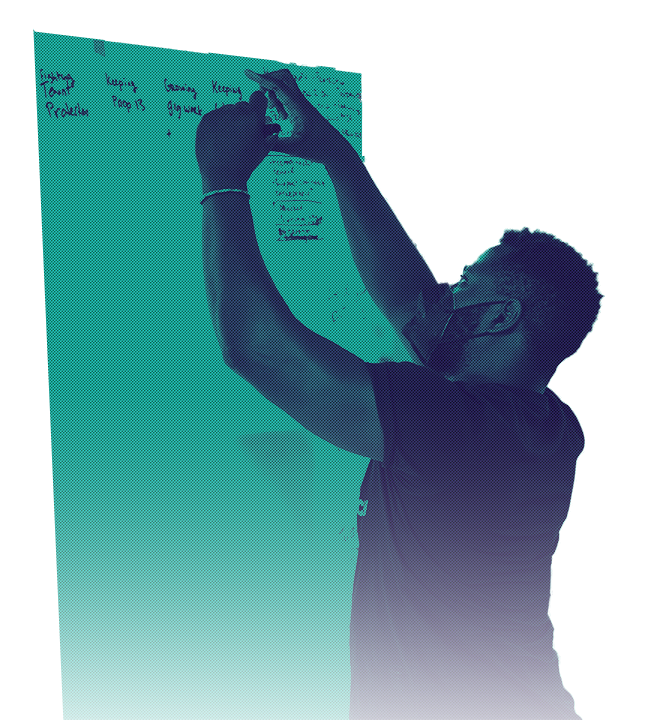
In this final section, we look forward, exploring some growth edges of the California program. Further developing the capacity to meet the complexity of the state and building co-governance for greater democracy will be important to the program’s future. As these needs and goals are not unique to the California program, they also offer key learnings for other networks and the broader movement.
Capacity to Meet Complexity
With the complexity of systems, relationships, and a changing environment comes strategies that need to be regularly tested and adapted. The California program has purposely developed as a nimble and responsive assembly bringing together and supporting the affiliates, while also serving as a vehicle for collective statewide power building. It has been a generative and supportive space for the affiliates where they can strategize together, make meaning, and experiment.
The affiliates and program staff are plugged into many issue areas and moving external campaigns, while also building infrastructure and internal network alignment. A growth edge for the program will be to balance multiple demands and strengthen its infrastructure without losing this agility and responsiveness. There are always campaigns vying for attention, which raises difficult choices about where the California program should prioritize its strategies, time, and energies — and when to let go of spaces where the network’s contribution is not as essential.
This has been particularly difficult during a pandemic when affiliate and network staff had to divert time and energy for rapid response. Coming back to the long term agenda will guide this prioritization: helping to ensure that each campaign or effort is tied to advancing one or more strategic imperatives and creating conditions that open future possibilities for bigger fights.
Through evaluation and experimentation, the program team is learning how to focus and best mobilize network staff and the affiliates to optimize and amplify the network’s impacts. PowerSwitch and its affiliates are investing in growing leadership capacity and pathways in the movement. There is a critical need for the affiliates to increase their capacity for corporate campaigning and networked strategies to grow statewide power. This will require affiliates to bring along all their staff and leadership, as well as their board and local allies.
Another complex area that is always evolving — and therefore demands ongoing attention and capacity — is the battle over what worldview will have dominance. Narrative interventions can have huge effects, such as holding corporations accountable by creating acute public relations, operational, or financial crises, or shifting perspectives over time to change what’s recognized as common sense. Corporations and their lobbyists, front groups, and allies devote major resources to shaping public narratives about how, in an uncertain economy, equitable policies would kill jobs, place undue burden on businesses, make private ventures too regulated and less efficient, and even increase crime. As one advisory committee member pointed out, “these narratives come from decades of a neoliberal drumbeat.”
The success of the corporate-backed Proposition 22 in 2020 is a clear example of this challenge. The opposition co-opted the workers’ narrative so that voters believed they were supporting workers by voting for the proposition. Similarly, the Schools and Communities First initiative (Proposition 15) failed because the corporate opposition was able to smear it with the tried-and-true narrative about over-taxing the middle class. At the same time, the pandemic created a narrative opening to redefine who essential workers are, the value of work, the disparity of wealth, and the role of government.
Shifting worldviews takes time, expertise, and discipline when faced with immediate and competing demands. PowerSwitch will need to chip away against corporate-driven ideologies, but, more importantly, it will also need to uplift alternative and worker-centered narratives so that they become conventional wisdom. Above all, this kind of narrative change relies on base building. Worker-centered narratives cannot be developed, let alone advanced, without the alignment and collective power of the people whose experiences and interests they center. Returning to the long term agenda reminds us of the strategic imperative to grow civic organizations and leadership for building a more authentic democracy — which leads us to the next area for further development.
Co-Governance for Stronger Democracy
The California program is still evolving, including future considerations about which networked campaigns to focus on. What is clear, however, is that achieving the network’s goals requires connecting the program’s campaigning and organizing with the co-governance approach that affiliates are using at the local level.
Creating and supporting co-governance is broader and bigger than getting sympathetic leaders elected or engaging in big public planning processes (though both have important roles). Even with policy wins, limited state enforcement and corporate-aligned elected officials in local regions often dull the impact of these victories. Corporate interests have been successful at using their financial muscle to effectively run cities.
Broader co-governance helps shift power into the hands of residents and working people, requiring greater transparency and making elected officials and civil servants more accountable to impacted communities. Co-governance requires a level of comfort with both inside and outside strategies; it is based on an agenda that is set by directly affected people, who guide the work of those inside and hold them accountable. To stay true to this agenda requires changes in the practices and structures of governance to implement open planning and decision making processes for ongoing input and real-time collaboration on policy development from the outside. True co-governance does not only play lip service to impacted community participation, it is a fundamental driving force.
True co-governance happens in a more authentic democracy through processes that empower impacted people to not only be engaged but to act as decision makers, including administrative, executive, and legislative roles. It means that residents and community leaders can step into these leadership positions that carry out policies and programs, allowing them to not only govern over public resources but to also shape the economy. It places people in governing roles that have a deep commitment to the role of government as a vehicle to serve and care for its residents.
Even with more elected or appointed grassroots leaders who support multiracial feminist democracy and economies, it takes a lot of work to train those individuals to step into powerful positions. Then, if and when they’re inside, it takes tremendous energy to support them, especially if they are not part of a governing majority.
As the affiliates are developing local leaders and advancing policy through inside/outside strategies, it will be important for the California program team to connect this local co-governance work with rigor around implementation of state-level wins. In general, movements tend to be more oriented around campaigns and are not as well set up for implementing policies or enforcement. Multifaceted braided strategies create the conditions for organizing and power building that can lead to greater co-governance. This is a long term endeavor that requires different organizational forms, organized bases with a lot of leadership capacity, and sufficient funding and revenue models. Making sure that implementation and co-governance are building on each other is an essential aspect of the work that needs attention and more support.
"Electing people, putting our own people on boards and commissions — that’s an important feature of what’s going on in CA. There’s a pipeline, but it needs to be more intentional. And not just electeds, but also staff, that might be even more important. "
- Advisory Group Member
Part 8
Conclusion
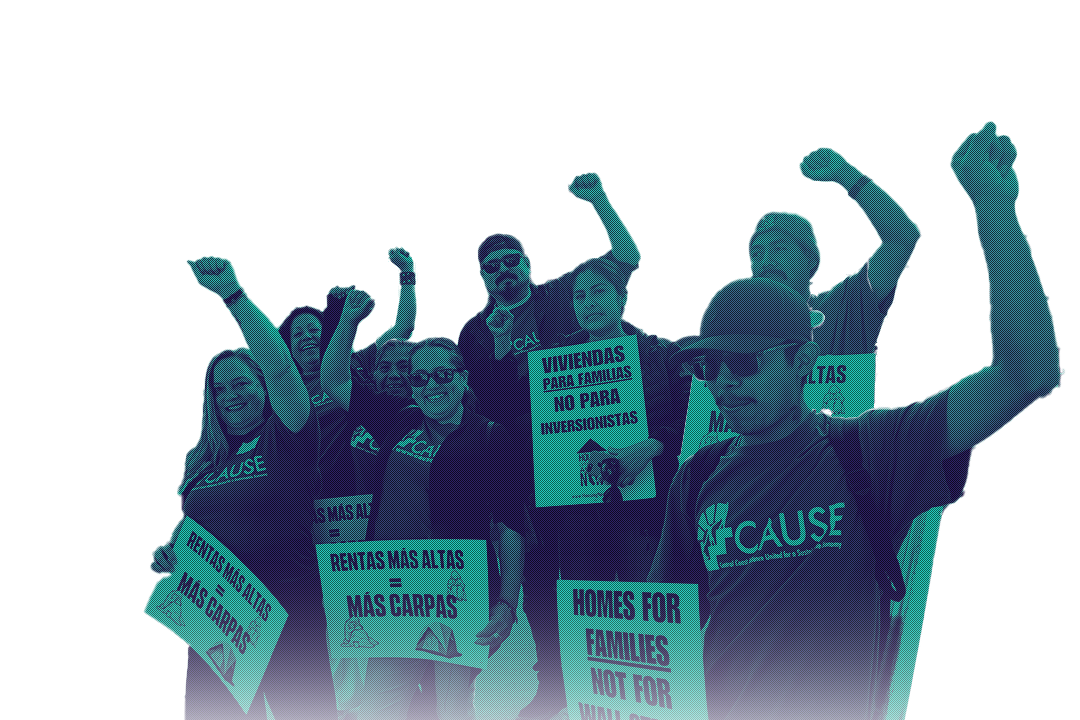
The story of PowerSwitch Action, shared here with some of its strengths, accomplishments, and learnings, began decades ago — with the network originating from the California affiliates and then expanding nationally. Building on its rich history, the network continues to build worker and community power, and to learn and adapt even during some of the most challenging times. Still relatively new as a statewide force, PowerSwitch’s California program is gaining recognition. As it matures, the program has been honing and growing networked campaigns to meet the complexity of the state. It has been fascinating for us to come full circle by returning to the formation of the California program. The leaders we got to know over these years are collaborating deliberately and organizing inclusively with their community and labor partners.
We’ve seen how their approach to forging multiracial feminist spaces, with its intersectional and nuanced approaches, is both appreciated and effective. We’ve also seen how focusing on top-down state policy strategies isn’t enough to sustain change. PowerSwitch’s long term agenda challenges consolidated corporate power and maps out a direction for changing the balance of power to favor working communities. Buying into and supporting their braided strategies that connect to this agenda creates the synergy that is needed for more sustained successes on local, state, and national scales.
This evaluation was intended to be informative and capture the early years of an emerging statewide network, but it has become more than that. It also serves as an invitation for more leaders, partners, and communities to engage and step into this movement for greater democracy — one that is more salient than ever. We are all stakeholders in envisioning a people- and planet-centered economy, and there is a lot at stake. PowerSwitch Action is modeling what a multiracial, feminist, equity-centered movement can be — with all of its complexity and promise — and how that can lead to an economy, democracy, and society that work for everyone.
Part 9
Appendices
Appendix A: Evaluator Biographies
Eric Wat documents the histories of and lessons from progressive movements through collective storytelling in the form of research and evaluation, organizational development, strategic facilitation, and leadership coaching. He is the primary author of South Central Rooted, a movement building report for the South LA Building Healthy Communities that articulates the intersections of gentrification, poverty, mass incarceration and environmental racism in that region. In 2022, he co-facilitated a series of discussions about the learning framework for the Just Prosperity initiative at the James Irvine Foundation among grantees from different sectors (organizing, advocacy, research, capacity building) to build an economy that works for all Californians. He also collected stories for the California LGBTQ Health and Human Services Network from LGBTQ+ clients in order to improve behavioral health services in Marin County. His book Love Your Asian Body: AIDS Activism in Los Angeles (2022) won the Book Award in History at the Association of Asian American Studies.
Rachel Rosner is dedicated to supporting multiracial/cultural groups organizing for social justice through research, assessment, and planning. Her experience began in the labor movement with the United Farmworkers in South Texas and later in California. She collaborates closely with social movements and networks across geographies and issues, always centering equity. Recently, she has co-authored with the Equity Research Institute — and in collaboration with Caring Across Generations and SEIU 775 — the report Washington Long-Term Care Trust Fund: A CAMPAIGN EXPLAINED (2019), documenting a multisector collaboration on the first publicly funded long-term care policy; assessed the Network Weaver Learning Lab led by Change Elemental and CompassPoint, producing the report Sowing Seeds: Cultivating Growth and Harvesting Learning (2019); and conducted a five year internal assessment for the LIFT (Labor Innovations for the 21st Century) Fund titled Lifting up the Learning: LIFT-Funded Worker Center-Union Collaboration and Organizing (2018)
Appendix B: Evaluation Methods and Process
Original Learning Questions:
As a network, how does the PowerSwitch Action CA program and its affiliate parts advance the worker movement, the future of workers, and worker power? What are we doing well? Where could we improve?
What are the impacts of the PowerSwitch Action CA program in the universe of those experimenting with base-building models, including models of worker organizing?
How are we building on the PowerSwitch Action CA program’s collective strengths both within and beyond the network, and what are we learning about addressing the challenges?
How can statewide strategy create a better cycle of building local power and organization and vice versa?
How is our centering of racial and gender justice impacting the worker movement — including differences with more women and people of color leading the historically white male-dominated labor sector?
Are we moving the field to challenge corporate power more? What effects or impacts are we having?
The evaluation employed a mixed-method approach, including:
Document and literature review (especially drawing on research on movement networks, system leadership, co-governance, and models of workers organizing);
Participant observation of one-on-one check-ins and two planning retreats between California staff and affiliates;
Monthly reflection meetings with the CA program director to capture progress and learnings;
Consulting with the advisory committee for their input and perspectives; and
Key informant interviews with seven stakeholders and 3 interviews with PowerSwitch Action’s Executive Director.
Definitions of CA program and network impact: Throughout the report, we’re mindful of distinguishing between the effects of the affiliates’ work and those of the CA program. Sometimes they are distinct, and sometimes they overlap. Examples of this include:
Where affiliates led with the support of the CA program;
Where the CA program led affiliates when they couldn’t have had as much impact on their own; and
Instances where the CA program led or co-led.
We convened an advisory committee to provide guidance for the evaluators.
Kimberly Alvarenga, California Domestic Workers Coalition
Donald Cohen, In the Public Interest
Hollie Russon Gilman, New America
Kyra Greene, Center on Policy Initiatives*
Kathy Hoang, PowerSwitch Action
Lauren Jacobs, PowerSwitch Action
Sheheryar Kaoosji, Warehouse Worker Resource Center*
Elly Matsumura, PowerSwitch Action
Derecka Mehrens, Working Partnerships USA*
Michelle Miller, Coworker.org
Mariah Montgomery, PowerSwitch Action
Maricela Morales, Central Coast Alliance United for a Sustainable Economy*
*indicates PowerSwitch California Affiliates
Appendix C: Key Campaign Definitions
Networked campaign: Work on a generally shared set of issues and/or narrative to advance what makes sense for affiliate organizations in their context. Affiliates are engaged in some kind of work on the issue, and multiple affiliates may coordinate through other formations and may caucus sometimes as a network to move an agenda in those spaces. This way they are building capacity and momentum in case there’s a moment to spring into more closely coordinated action. Historical examples include minimum wage, living wage, and community benefits agreements campaigns.
Emerging campaign: Work on a shared issue or policy with a shared narrative while organizing on a single or multiple issues in different places at different times. This way the network engages in a series of (or simultaneous) local wins across the state to build momentum toward bigger wins. Some affiliates invest significant capacity into leading key elements of a single, shared campaign, or run whole, potentially multifaceted local campaigns; others invest targeted capacity at key moments. Example: Amazon.
Community benefits agreements: A community benefits agreement is a contract between a community-based organization(s) and the developer of a proposed project. It serves as an economic empowerment mechanism by which stakeholder organizations can negotiate directly with developers for the benefits most important to them, shaping urban development projects to improve lives for local residents, most frequently communities of color. CA affiliate examples of community benefits agreements: one of the original CBAs at the Staples Center and LA World Airports (LAANE). Some CA affiliate examples of living wage campaigns: bus drivers and hotels to meet wage and hiring standards (CPI); City of San Jose (Working Partnerships USA); Ventura County and the Cities of Oxnard, Ventura, Port Hueneme, and Santa Barbara (CAUSE).
Living wage and minimum wage campaigns: Minimum wage campaigns seek to raise the federal and state wage laws that set the lowest amount that covered employees can earn an hour. A living wage is a level of pay that allows someone to meet their basic living expenses, including rent, food, transportation, health care, and other necessities. This rate can vary in localities and states as the cost of living varies. Now a global movement, living wage campaigns have successfully raised wages in hundreds of places across the country.
Fight for $15: The Service Employees International Union (SEIU) helped create the Fight for $15 movement that successfully advocated for raising wages for low-income workers to $15 an hour. In California in 2022, AB 257, the Fast Food Accountability and Standards (FAST) Recovery Act, passed in California, creating a first-of-its-kind council of workers, corporate representatives, franchisees, and state officials with a mandate to set minimum industry standards on wages, working hours, and other conditions for fast-food workers statewide.
